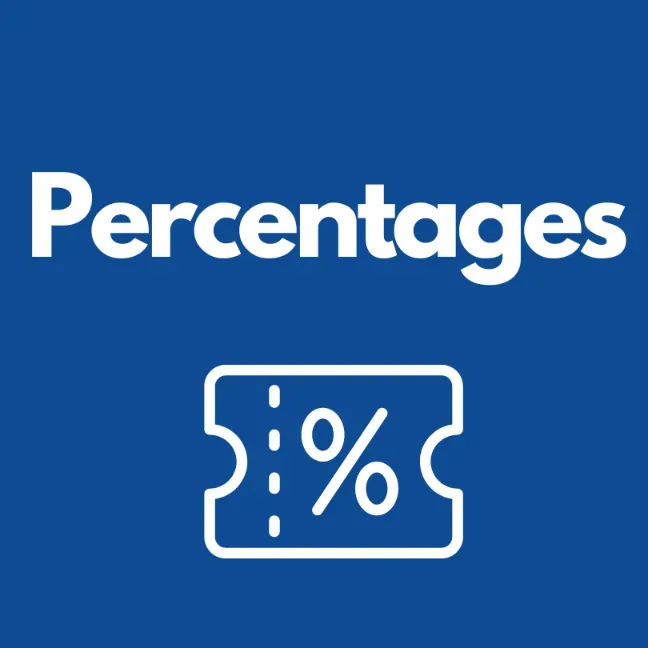Percentage Difference Calculator
Enter two values to calculate the percentage difference
Related Percentage Calculators
See all maths calculators
Percentage Difference Calculator Guide
The Percentage Difference Calculator is a valuable tool that allows you to measure the relative difference between two values as a percentage. This comprehensive guide will walk you through the process of using such a calculator, explain the concepts behind percentage difference, provide practical examples, and offer insights into common pitfalls and real-world applications.
Understanding Percentage Difference
Before diving into the calculation process, let's clarify some key concepts:
Percentage Difference
Percentage difference is a way of expressing the difference between two values as a percentage of their average. It's particularly useful when comparing two quantities that are similar in magnitude but don't have a clear "before" and "after" relationship.
Formula for Percentage Difference
The basic formula for calculating percentage difference is:
The formula for calculating percentage difference is (|Value 1 - Value 2| / ((Value 1 + Value 2) / 2)) × 100.
Where |x| denotes the absolute value of x.
Calculating Percentage Difference
To calculate the percentage difference between two values:
- Find the absolute difference between the two values.
- Calculate the average of the two values.
- Divide the absolute difference by the average.
- Multiply by 100 to convert to a percentage.
For example, to calculate the percentage difference between 50 and 60:
- |50 - 60| = 10
- (50 + 60) / 2 = 55
- 10 / 55 ≈ 0.1818
- 0.1818 × 100 ≈ 18.18%
Therefore, the percentage difference between 50 and 60 is approximately 18.18%.
Examples of Percentage Difference Calculations
Let's look at a table of examples:
| Value 1 | Value 2 | Calculation Process | Percentage Difference |
|---|---|---|---|
| 100 | 120 | ( | 100 - 120 |
| 50 | 40 | ( | 50 - 40 |
| 75 | 85 | ( | 75 - 85 |
| 200 | 180 | ( | 200 - 180 |
| 30 | 30 | ( | 30 - 30 |
Common Mistakes to Avoid
When using a Percentage Difference Calculator, be aware of these common pitfalls:
-
Confusing percentage difference with percentage change: Percentage difference is symmetrical and doesn't depend on which value is considered "initial" or "final".
-
Forgetting to use absolute values: The numerator should always be positive.
-
Misplacing decimal points: Be careful when dividing and multiplying by large numbers.
-
Forgetting to multiply by 100: Remember that percentage difference is expressed as a percentage, so you must multiply by 100.
-
Misinterpreting zero difference: A result of zero means the two values are identical.
Practical Applications
Understanding how to calculate percentage difference has numerous real-world applications:
Scientific Measurements
Percentage difference is used to compare experimental results or measurements.
Example: If two methods of measuring a chemical concentration yield results of 0.52 g/L and 0.48 g/L, the percentage difference is about 8.00%.
Quality Control
Manufacturing processes use percentage difference to assess consistency in product specifications.
Example: If two batches of a product have average weights of 98g and 102g, the percentage difference is about 4.00%.
Market Research
Comparing survey results or market shares often involves percentage difference calculations.
Example: If two competing products have market shares of 35% and 40%, the percentage difference is about 13.33%.
Sports Analytics
Percentage difference can be used to compare player or team statistics.
Example: If two basketball players have scoring averages of 22 points and 26 points per game, the percentage difference is about 16.67%.
Real World Analogies (RWA)
To better understand percentage difference, consider these real-world analogies:
-
Comparing Recipes:
- If one recipe calls for 300g of flour and another calls for 330g, the percentage difference is about 9.52%.
-
Height Differences:
- If two siblings are 165cm and 175cm tall, the percentage difference in their heights is about 5.88%.
-
Salary Comparison:
- If two job offers have annual salaries of $50,000 and $55,000, the percentage difference is about 9.52%.
-
Temperature Variations:
- If the temperature in two cities is 20°C and 24°C, the percentage difference is about 18.18%.
These real-world analogies help to ground abstract percentage difference concepts in concrete, everyday situations, making them easier to understand and remember.
Using Technology: Percentage Difference Calculators
While it's important to understand the concept, Percentage Difference Calculators can quickly perform calculations for complex data sets or when precision is needed beyond simple mental math. When using such calculators:
- Verify the input format required by the calculator.
- Double-check your entries for accuracy.
- Understand the output format provided by the calculator (decimal places).
- Use the results judiciously, especially in professional or academic contexts where showing your work may be required.
The Importance of Understanding Percentage Difference
Understanding percentage difference is crucial for various fields including science, quality control, market research, and sports analytics. It provides a standardized way to compare two values, regardless of their absolute magnitudes, and helps in making informed decisions based on quantitative data.
Conclusion
Using a Percentage Difference Calculator to measure the relative difference between two values as a percentage is a valuable skill that enhances your ability to compare and analyze data. Whether you're conducting scientific experiments, assessing product quality, or analyzing market trends, understanding percentage difference can improve your analytical capabilities and decision-making skills.
Remember, while calculators are powerful tools, understanding the underlying concepts is crucial. Practice manual calculations alongside using calculators to develop a deep understanding of how percentage differences reflect the relative magnitude of differences between values.
Key Takeaways
- The formula for calculating percentage difference is (|Value 1 - Value 2| / ((Value 1 + Value 2) / 2)) × 100.
- Be aware of common mistakes like confusing percentage difference with percentage change or forgetting to use absolute values.
- Recognize practical applications in scientific measurements, quality control, market research, and sports analytics.
- Use real-world analogies to better understand and remember the concept.
- While calculators are helpful, understanding the manual process is crucial for developing mathematical intuition.
- Remember that percentage difference is always positive and symmetrical, meaning it doesn't matter which value is considered first or second.
By mastering the concept of calculating percentage differences, you'll have a powerful tool at your disposal for comparing and analyzing data in various real-world scenarios!

